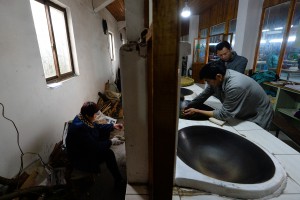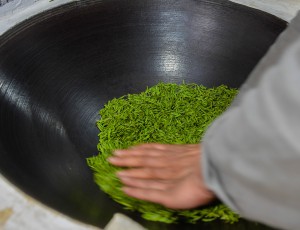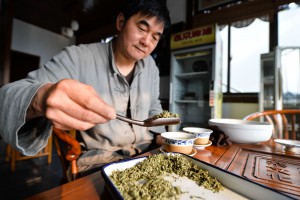Category Archives: News
中瑞医疗器械合作交流与职业发展论坛暨中瑞生命科学协会2016年年会在斯德哥尔摩成功举办



 北欧绿色邮报网报道(特约记者丹妮)--2016年3月13日,由中瑞生命科学协会主办的“中瑞医疗器械合作交流与职业发展论坛暨中瑞生命科学协会2016年年会”在斯德哥尔摩的皇家理工学院成功召开。
北欧绿色邮报网报道(特约记者丹妮)--2016年3月13日,由中瑞生命科学协会主办的“中瑞医疗器械合作交流与职业发展论坛暨中瑞生命科学协会2016年年会”在斯德哥尔摩的皇家理工学院成功召开。本次论坛围绕中瑞医疗器械领域的合作前景以及生命科学专业留学人员在瑞典的职业发展等主题展开了探讨,为中瑞生命科学相关领域的专业人士提供了一次深入交流的机会。
从比利时首都发生爆炸案想到的
晨曦
前段时间在北京,为了避免楼上楼下的搜身检查,我开始喜欢地面的汽车和出租车了。至少,这样我不用来回提箱子。
我心想,这检查好象在飞机场了。真严格。
然而,比利时首都布鲁塞尔的爆炸造成21人死亡,几十人受伤,突然让我觉得,与其自由挨炸,或许小心谨慎更好。虽然有点儿烦,但是,这样安全。中国人确实关心的无微不至。
而西方的自由却要付出代价。
据了解,这是一场有计划有预谋的自杀式袭击。是恐怖袭击。
对于恐怖分子,需要管教一下。同时,教育还是最最重要的。重要的是要教育人们尊重生命,不要当亡命徒。教育人们要有文化,有知识,有能力在这个纷繁复杂的世界生存。人之所以是人,就是因为他不是动物,任何象动物一样的弱肉强食,最终导致的结果依然是弱肉强食。没有文明可言。
瑞典安全部门在审视安全警戒级别
北欧绿色邮报网报道(记者陈雪霏)--瑞典内政大臣于格曼说,鉴于比利时发生自杀式爆炸,瑞典安全部门正在审视安全警戒级别。
瑞典去年11月巴黎发生恐袭时把安全警戒提到4级,高危级别。最高5级。但三周前,考虑到国内的形势,把危险级别降到了3级。
目前是否要恢复四级,安全部门正在审视。
比利时首都布鲁塞尔,也是欧盟总部,今天早上发生自杀式炸弹轰炸,造成10多人死亡。无数人受伤。
河北正定:明代广济桥重见天日
图片新闻--两只火烈鸟飞临黄河
Interview: Belt and Road Initiative enhances Sino-Greek ties, Greek official
by Maria Spiliopoulou
ATHENS, March 10 (Xinhua) — A decade after Greece and China forged a comprehensive strategic partnership, especially after the launch of China’s Belt and Road Initiative, their cooperation has progressed remarkably.
“Sino-Greek economic relations have been strengthened in recent years in several sectors: from bilateral trade and investments to cooperation in technology and research,” Christos Staikos, chairman of Enterprise Greece, a Greek investment promotion body, told Xinhua.
Staikos noted that Greece is a major spot in the context of the Belt and Road Initiative and that China is becoming one of the main strategic partners of Greece on the road to recovery.
“All these factors create a stable framework for the further improvement of bilateral trade and business cooperation,” Staikos stressed.
Bilateral trade increased 5.6 percent in 2014 and Chinese investment in Greece rose from 249 million euros (273 million U.S. dollars) in 2010 to 1.2 billion euros (1.3 billion dollars) in 2014, according to official Greek figures.
Quality Greek food products, as well as luxury products such as fur, jewelry and cosmetics are becoming more and more popular in China.
Enterprise Greece said the prospects are exceptional as Chinese consumers start to learn and trust the quality of Greek products and Greek companies.
In the field of investment, Staikos highlighted the development of the seaport of Piraeus, describing it as an entry point into Europe as it has been included in the Belt and Road Initiative.
“The investment creates prospects in areas such as logistics and shipbuilding in parallel with the interest Chinese companies have already demonstrated in tourism and real estate, energy, food and transport,” he said.
Furthermore, the Golden Visa program, under which with the purchase of real estate worth 250,000 euros (274,000 dollars), three generations (parents, children and grandchildren) get long-term residence permit in Greece and Schengen visa, has been embraced by Chinese families who would like to have a basis in Europe for leisure and business activities, the Greek official added.
Tourism presents similar opportunities, according to Enterprise Greece.
“Chinese respect the Greek civilization and discover the beauty of our country, visiting all tourist destinations throughout the year,” Staikos underlined.
Chinese tourist arrivals increased 70 percent year-on-year to 100,000 in 2014, according to official figures.
“Enterprise Greece in recent years is in systematic contact with Chinese companies, informing them of the potential of our country and enabling them to explore opportunities and make their next business steps,” said Staikos.
Piraeus Container Terminal, a subsidiary of China Ocean Shipping Group that manages Piers II and III at Piraeus, won an international tender for the acquisition of 67 percent stake in Piraeus Port Authority, which manages Pier I.
“I believe it is a positive development for the Greek economy, a key parameter in the Maritime Silk Road which enhances the strategic importance of Piraeus,” said Ioannis Tzoannos, an economic professor and former general secretary of the Greek shipping ministry.
The sea and the shipping industry was and remains the key element in the development of bilateral relations, and the Maritime Silk Road opened routes for trade and cultural contacts and stronger cooperation in more fields, Tzoannos stressed.
He urged Chinese investors to get more involved in the Sino-Greek cooperation, in particular in the maritime sector.
“As European banks are withdrawing from the shipping sector due to the crisis, in my view it is in the interests of China to get more involved. Risk taking is important in times of crises to find opportunities,” he said. Enditem
Editor Xuefei Chen Axelsson
Xinhua Insight: Lawmakers approve China’s five-year plan against economic headwinds
BEIJING, March 16 (Xinhua) — Chinese lawmakers on Wednesday approved the country’s economic and social development blueprint for the 2016-2020 period, which sets targeted average annual economic growth at above 6.5 percent in the next five years.
A total of 2,778 lawmakers, or 97.27 percent, voted in favor of the five-year plan at the closing meeting of the annual session of the National People’s Congress (NPC).
China has set 2020 as the target year to realize the first “centenary goal” of building a moderately prosperous society in all respects, pledging efforts to double GDP and per capita personal income from the 2010 level before the Communist Party of China’s 100th anniversary of founding in 2021.
To this end, the five-year plan aims to keep medium-high growth in the next five years. By 2020, the size of China’s economy is expected to exceed 90 trillion yuan (13.8 trillion U.S. dollars), compared with 67.7 trillion yuan in 2015, according to the plan.
Addressing fellow lawmakers at the closing meeting, top legislator Zhang Dejiang called the 13th Five-Year Plan a document of “guiding importance” in the final stretch toward building a moderately prosperous society in all respects.
His words came amid rising economic headwinds in China, with uncertainties clouding global economic recovery.
China’s economy expanded 6.9 percent year on year in 2015, the slowest in a quarter of a century, weighed down by a property market downturn, falling trade and weak factory activity.
The government now hopes to shift the economy from the previous mainstay of exports and investment toward services and consumer spending.
According to the five-year plan, the reform and opening up drive will continue between 2016 and 2020.
China will push ahead urbanization and agricultural modernization, coordinate development in urban and rural areas, and work to improve the people’s well-being across the board so that all people can share the fruits of development.
An innovation-driven development strategy shall be implemented, while industries must be propelled toward medium-high end, the document read.
By 2020, advances should be made in core technologies such as information communication, new energy, new materials, aviation, biological medicine and intelligent manufacturing, it said.
The environment is another key priority in the 2016-2020 plan.
As binding targets, water consumption per 10,000 yuan of GDP will fall 23 percent by 2020, while energy consumption per unit of GDP will be cut by 15 percent. Carbon dioxide emissions will also be cut by 18 percent.
Major progress should be made on the China-proposed Belt and Road Initiative, and the service trade’s share in total foreign trade would be increased.
“The five-year plan has offered a clear roadmap for the fulfillment of our centenary goal,” said Liu Xiya, an NPC deputy.
In his government work report, Premier Li Keqiang said China had successfully fulfilled all the main tasks and targets set out in its 12th Five-Year Plan (2011-2015), setting a positive tone for the implementation of the new one.
Chinese can derive great confidence and a strengthened sense of unity from the country’s achievements, drawing on them to forge ahead on this new leg of the journey toward the Two Centenary Goals, he said.
His optimism was shared by Liu. “The next five years will mark the home stretch to 2020 target, and there is every reason to believe that we can deliver on those targets since our economic fundamentals are still sound,” she said.
The drafting of the new plan started early. A plenary session of the Communist Party of China (CPC) Central Committee last year was dedicated to review proposals for the five-year development blueprint and set its overarching principles.
A draft version of the plan was submitted to lawmakers for review at this year’s annual legislative session, during which dozens of changes were made.
Kan Ke, an official with the secretariat of this year’s NPC session, said the formulation of the final document was a very China-style political process: The proposition of the ruling Communist Party becomes the will of the state in a due course of legislative procedures.
He added that the drafting process was in line with the evolution of modern state governance, and is conducive to the implementation and enforcement of the Party’s decisions.
His words were echoed by Zheng Yongnian, professor and director of the East Asian Institute of the National University of Singapore.
Zheng hailed the consistency of China’s political and economic design in comparison with the West, where “a political party may make plenty of pledges before elections, but fail to deliver after coming to power.”
Kan agreed. “Coherence is the basis for our economic and social development. This is where our institutional superiority comes from,” he said. Enditem
Editor Xuefei Chen Axelsson
China urges EU to accept its market economy status
BEIJING, March 10 (Xinhua) — China on Thursday urged the European Union (EU) to obey the rules of the World Trade Organization (WTO) and stop its unfair treatment of China.
Foreign Ministry spokesperson Hong Lei made the remarks following comments by EU Trade Minister Cecilia Malmstrom on Wednesday. She said the EU must maintain solid trade defenses even if it decides to grant China market economy status.
China joined the WTO in 2001. The WTO accession protocol means China will automatically transit to a market economy for Europe by Dec. 11, 2016, the 15th anniversary of its accession to the organization. However, Europe insists this must be debated.
“We’ve heard different opinions on China’s market economy status from the EU recently,” Hong said, noting that China had fulfilled its obligations since becoming a member of WTO.
So far, over 80 countries, including Russia, New Zealand, Singapore and Australia, have recognized China’s status as a market economy.
China is now the EU’s second largest trading partner and one of the biggest markets for the 28-member bloc.
The EU is an important member of the WTO, a vital supporting force to the multilateral trade and international legal systems, Hong said, adding that China hopes the EU will fulfill its commitments to China’s entry into WTO. Enditem
China to promote clean coal for better air: minister
BEIJING, March 11 (Xinhua) — China’s environmental protection minister Chen Jining said Friday that the country is promoting the clean use of coal to curb air pollution.
“China’s air quality is mainly caused by our energy structure, coal consumption specifically,” Chen said at a press conference on the sidelines of the annual parliamentary session.
Chen said China attaches great importance to adjusting the energy structure, one of the tasks in the draft 13th Five-Year Plan (2016-2020).
China is promoting the clean use of coal and boosting low-emissions facilities for coal-fired power plants that rival those of gas-fired plants.
It will be a revolutionary effort that will overturn the conventional wisdom that coal is not clean, and positively impact efforts to curb smog, the minister said.
Chen added that China is also cutting emissions from household bulk coal. Emissions from one tonne of bulk coal are equivalent to those from five to ten tonnes of coal burned in power plants. As living standards rise, bulk coal consumption is increasing.
“Emissions from bulk coal contributed a lot to the heavy smog last winter,” Chen said, adding that the government will make more efforts to curb them.
“We will experience a long period of adjusting the energy consumption structure, during which we will promote clean energy, strengthen adjustments to energy consumption and promote clean use of coal,” Chen said. Enditem
图片新闻:祖国大地回春-湖北油菜花地
Photo: Traditional way of making Biluochun tea
Photo: China’s first green energy plane flies successfully
图片新闻:飞向“绿色航空”——我国首款新能源飞机诞生记
American travel market eyes Chinese tourists
BEIJING, March 18(Greenpost) — If there was just one thing the world’s two largest economies could agree on both wanting, tourism would be it.
China and the United States announced this week in Beijing that 2016 will be the year of mutual tourism promotion, one of the outcomes of President Xi Jinping’s visit to the United States last year.
The focus on tourism between the two countries come as overseas travel booms in China, in fact more Chinese vacation abroad than any other nation. More than 120 million Chinese traveled abroad last year, up 12 percent year on year, and they spent 104.5 U.S. billion dollars, up 16.7 percent over the same period.
“The scale and the speed with which the market [has] grow[n] is quite remarkable,” said Fred Dixon, CEO of NYC & Co., the agency responsible for promoting New York City, the top U.S. destination city for Chinese travelers.
Despite New York being the top destination less than 3 percent of Chinese outbound tourists go to the United States. The Republic of Korea, Japan and Thailand are much more popular choices, partly because of their proximity.
Despite this, Chinese visitors to the United States has been growing at a double digit rate over the past few years.
In 2015, 2.67 million Chinese visited the United States, compared with less than 400,000 in 2007. Goldman Sachs estimates that the number of Chinese visitors will almost double to 5 million by 2025.
This growth prospect has excited tourism players across the States. Many have sent delegations to China and the news about the tourism exchange will no doubt see them double down their promotional efforts.
Dixon said his organization’s budget for promoting New York inChina has risen in recent years, and is outpacing growth of marketing expenditure for other destinations.
Travel agencies and tourism promoters say a more powerful boost to Chinese tourists inflow to the U.S. is visa relaxation. In November 2014, the two countries extended visa validity for tourists from one to 10 years.
This policy has pushed up the share of Chinese travelling to the United States purely for leisure. Data compiled by various popular destination cities in the United States show that for Chinese visitors, leisure travelers have begun to outnumber business travelers in many places.
“The 10 year visa extension is really a game changer,” Dixon said, adding that the relaxation has paved the way for more Chinese to visit the United States for pure leisure and on their own, instead of on business trips or organized group tours.
Chinese online travel service provider Ctrip also reported a surge in U.S. visa application through its platform between January to August last year following the visa relaxation.
With more tourists heading to American shores on their own, tourism promoters say they are reviewing their messages here in China. While travel agencies are still valuable partners, they have begun to engage with prospective travellers directly.
“In the very beginning our work was very much about working closely with the trade [travel agencies] on the group side, but now we are seeing a move toward independent travel,” Dixon said.
That shift led promoters to prioritize their online presence, as websites, social media and apps have become prime channels for information and planning.
More than 259 million Chinese booked their travel online last year, of which 80 percent did so on their mobile devices, according to ChinaInternet Network Information Center.
The demographics are changing too. China’s outbound travel boom is fueled mostly by a new generation of travelers. 67 percent of China’s overseas tourists in 2014 were born after 1980s, data compiled by Goldman Sachs show.
All these changes impact travel decisions. Promoters say group travelers want to see iconic sites and things they have seen on TV and in the movies. But reaching out to the new generation of savvy Chinese outbound travelers takes more than that.
The appeal for them, Dixon said, lies beneath the surface, in lesser known communities, parks and museums that add more personal character to their travel experience.
“This is an exciting time,” he said. “You don’t often see a market emerge the way China has. And we probably won’t see anything like this again.” Enditem
Source: Xinhua


































